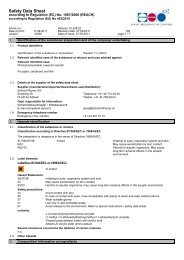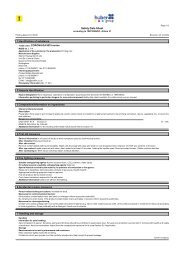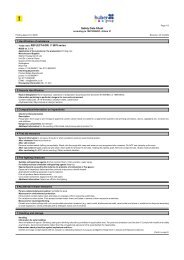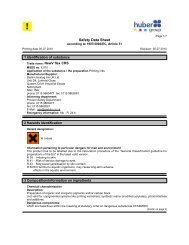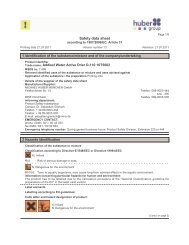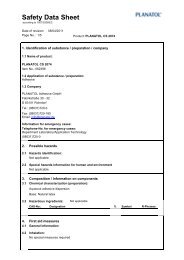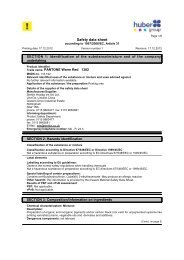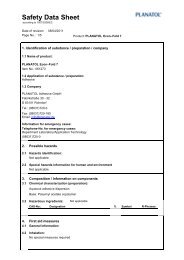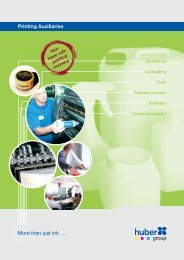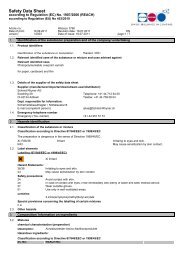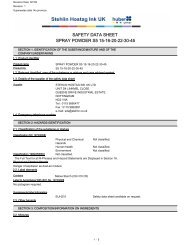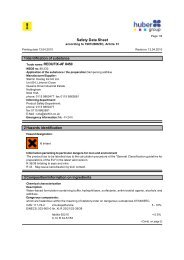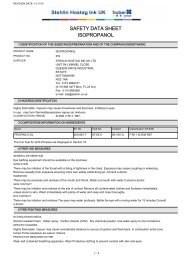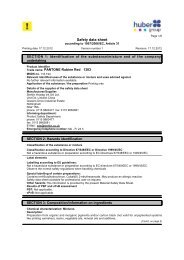Wessco Gloss Lacquer 1722 - Stehlin Hostag UK
Wessco Gloss Lacquer 1722 - Stehlin Hostag UK
Wessco Gloss Lacquer 1722 - Stehlin Hostag UK
Create successful ePaper yourself
Turn your PDF publications into a flip-book with our unique Google optimized e-Paper software.
Safety Data Sheet<br />
according to Regulation (EC) No. 1907/2006 (REACH)<br />
according to Regulation (EU) No 453/2010<br />
Article no.:<br />
Date of print: 20.09.2011<br />
version: 1.0003<br />
<strong>Wessco</strong> <strong>1722</strong><br />
Revision date: 18.07.2011<br />
EN<br />
Date of issue: 18.07.2011 page:1 / 7<br />
1. Identification of the substance/ preparation and of the company/ undertaking<br />
1.1. Product identifiers:<br />
Identification of the substance or preparation:<br />
1.2. Relevant identified uses of the substance or mixture and uses advised against<br />
Relevant identified uses<br />
Photopolymerisable overprint varnish<br />
for paper, cardboard and film<br />
1.3. Details of the supplier of the safety data sheet<br />
Supplier (manufacturer/importer/downstream user/distributor):<br />
Schmid Rhyner AG<br />
Soodring 29<br />
Telephone: +41 44 712 64 00<br />
CH-8134 Adliswil<br />
Telefax: +41 44 709 08 04<br />
Dept. responsible for information:<br />
Sicherheitsbeauftragter / Notfallauskunft<br />
E-mail (competent person):<br />
qhse@Schmid-Rhyner.ch<br />
1.4. Emergency telephone number<br />
Emergency (Tox.-Center) +41 44 251 51 51<br />
2. Hazards identification<br />
2.1. Classification of the substance or mixture<br />
Classification according to Directive 67/548/EEC or 1999/45/EC<br />
The preparation is dangerous in the sense of Directive 1999/45/EC.<br />
Xi; R36/37/38 Irritant Irritating to eyes, respiratory system and skin.<br />
R43<br />
May cause sensitization by skin contact.<br />
R52-53 Harmful to aquatic organisms. May cause<br />
long-term adverse effects in the aquatic<br />
environment.<br />
2.2. Label elements<br />
Labelling (67/548/EEC or 1999/45/EC)<br />
Xi Irritant<br />
Hazard Statements:<br />
36/37/38 Irritating to eyes, respiratory system and skin.<br />
43 May cause sensitization by skin contact.<br />
52/53 Harmful to aquatic organisms, may cause long-term adverse effects in the aquatic environment.<br />
Safety precautions:<br />
24 Avoid contact with skin.<br />
26 In case of contact with eyes, rinse immediately with plenty of water and seek medical advice.<br />
37 Wear suitable gloves.<br />
51 Use only in well-ventilated areas.<br />
61 Avoid release to the environment. Refer to special instructions / safety data sheet.<br />
contains:<br />
2,2-bis(acryloyloxymethyl)butyl acrylate<br />
(1-methyl-1,2-ethanediyl)bis[oxy(methyl-2,1-ethanediyl)] di- acrylate<br />
Addukt 20 Acrylic ester amino adduct<br />
Special provisions concerning the labelling of certain mixtures<br />
n.a.<br />
2.3. Other hazards<br />
3. Composition/ Information on ingredients<br />
3.2. Mixtures
Safety Data Sheet<br />
according to Regulation (EC) No. 1907/2006 (REACH)<br />
according to Regulation (EU) No 453/2010<br />
Article no.:<br />
Date of print: 20.09.2011<br />
version: 1.0003<br />
<strong>Wessco</strong> <strong>1722</strong><br />
Revision date: 18.07.2011<br />
EN<br />
Date of issue: 18.07.2011 page:2 / 7<br />
chemical characterization (preparation)<br />
Description:<br />
Hazardous ingredients:<br />
Acrylsäureester-Amino-Additionsprodukte<br />
Classification according to Directive 67/548/EEC or 1999/45/EC<br />
EC No:<br />
REACH No:<br />
CAS No.:<br />
Identification of the hazard:<br />
INDEX no.: classification:<br />
239-701-3<br />
15625-89-5<br />
607-111-00-9<br />
256-032-2<br />
42978-66-5<br />
607-249-00-X<br />
Additional information<br />
Full text of R-phrases: see section 16.<br />
4. First-aid measures<br />
4.1. Description of first aid measures:<br />
General information:<br />
Addukt 20 Acrylic ester amino adduct<br />
Xi; R36 / R43 / R52-53<br />
2,2-bis(acryloyloxymethyl)butyl acrylate<br />
Xi; R36/38 / R43<br />
01-2119484613-34-0001<br />
(1-methyl-1,2-ethanediyl)bis[oxy(methyl-2,1-ethanediyl)] di- acrylate<br />
Xi; R36/37/38 / R43 / N; R51-53<br />
% by weight<br />
Remark:<br />
25 < 50<br />
20 < 25<br />
20 < 25<br />
In all cases of doubt, or when symptoms persist, seek medical advice. In case of unconsciousness give nothing by mouth,<br />
place in unconscious position and seek medical advice.<br />
After inhalation<br />
Move victim to fresh air. Put victim at rest and keep warm. In case of irregular breathing or respiratory arrest provide artificial<br />
respiration.<br />
In case of skin contact:<br />
Take off immediately all contaminated clothing. After contact with skin, wash immediately with plenty of water and soap. Do<br />
not use solvents or thinners.<br />
In case of skin contact: Conditions to avoid: UV-radiation/sunlight.<br />
Causes mild skin irritation.<br />
In case of eye contact:<br />
If product gets into the eye, keep eyelid open and rinse immediately with large quantities of water, for at least 5 minutes.<br />
Subsequently consult an ophthalmologist. Remove contact lenses, if present and easy to do. Continue rinsing.<br />
After ingestion:<br />
If swallowed, rinse mouth with water (only if the person is conscious). Consult physician immediately. Keep victim calm. Do<br />
not induce vomiting.<br />
4.2. Most important symptoms and effects, both acute and delayed:<br />
4.3. Indication of any immediate medical attention and special treatment needed<br />
5. Firefighting measures<br />
5.1. Extinguishing media<br />
Suitable extinguishing media:<br />
alcohol resistant foam, carbon dioxide fire blanket, Powder, spray mist, (water)<br />
Extinguishing media which must not be used for safety reasons:<br />
Strong water jet<br />
5.2. Special exposure hazards arising from the substance or preparation itself, its combustion products or from resulting<br />
gases:<br />
Dense black smoke occurs during fire. Inhaling hazardous decomposing products can cause serious health damage.<br />
5.3. Special protective equipment for firefighters:<br />
Provide a conveniently located respiratory protective device.<br />
Additional information:<br />
Cool closed containers that are near the source of the fire. Do not allow water used to extinguish fire to enter drains, ground or
Safety Data Sheet<br />
according to Regulation (EC) No. 1907/2006 (REACH)<br />
according to Regulation (EU) No 453/2010<br />
Article no.:<br />
Date of print: 20.09.2011<br />
version: 1.0003<br />
<strong>Wessco</strong> <strong>1722</strong><br />
Revision date: 18.07.2011<br />
EN<br />
Date of issue: 18.07.2011 page:3 / 7<br />
waterways. Treat runoff as hazardous.<br />
6. Accidental release measures<br />
6.1. Personal precautions, protective equipment and emergency procedures<br />
Keep away from sources of ignition. Ventilate affected area. Do not breathe vapours. See protective measures under point 7<br />
and 8.<br />
6.2. Environmental measures<br />
Do not allow to enter into surface water or drains. If the product contaminates lakes, rivers or sewages, inform competent<br />
authorities in accordance with local regulations.<br />
6.3. Methods and material for containment and cleaning up<br />
Isolate leaked material using non-flammable absorption agent (e.g. sand, earth, vermiculit, diatomaceous earth) and collect it<br />
for disposal in appropriate containers in accordance with the local regulations (see chapter 13). Clean using cleansing agents.<br />
Do not use solvents.<br />
6.4. Reference to other sections<br />
Observe protective provisions (see chapter 7 and 8).<br />
7. Handling and storage<br />
Persons with a history of skin sensitisation problems should not be employed in any process in which this product is used.<br />
7.1. Precautions for safe handling<br />
Advices on safe handling<br />
Use only in well-ventilated areas. Keep away from heat sources, sparks and open flames. Avoid contact with skin, eyes and<br />
clothes. Do not inhale dusts, particulates and spray mist when using this preparation. Avoid respiration of swarf. When using<br />
do not eat, drink or smoke. Personal protective equipment: refer to chapter 8. Do not empty containers with pressure - no<br />
pressure vessel! Always keep in containers that correspond to the material of the original container. Follow the legal<br />
protection and safety regulations.<br />
7.2. Conditions for safe storage, including any incompatibilities<br />
Requirements for storerooms and containers:<br />
Storage in accordance with the Ordinance on Industrial Safety and Health (BetrSiVO). Keep container tightly closed. Do not<br />
empty containers with pressure - no pressure vessel! Smoking is forbidden. Access only for authorised persons. Store<br />
carefully closed containers upright to prevent any leaks.<br />
Hints on joint storage<br />
Keep away from strongly acidic and alkaline materials as well as oxidizers.<br />
Further information on storage conditions<br />
Take care of instructions on label. Store in a well-ventilated and dry room at temperatures between 5 °C and 35 °C. Protect<br />
from heat and direct sunlight. Keep container tightly closed. Remove all sources of ignition. Smoking is forbidden. Access only<br />
for authorised persons. Store carefully closed containers upright to prevent any leaks. Keep only in the original container.<br />
7.3. Specific end use(s)<br />
Observe technical data sheet.Observe instructions for use.<br />
Remarks for the production of food stuff<br />
Not suitable for varnishing of food stuff and other sensitive packaging. This applies for secondary packaging too, unless a<br />
barrier avoids migration of substances to the content. Before the finished secondary packaging is brought into circulation<br />
corresponding migration tests shall be conducted.<br />
8. Exposure controls / Personal protection<br />
8.1. Control parameters<br />
EC No:<br />
CAS No.:<br />
-<br />
Description: type: Limit value<br />
STEL (EC) TWA (EC)<br />
Additional information<br />
TWA (EC): Occupational exposure limit value<br />
STEL (EC): Short term occupational exposure limit value<br />
8.2. Exposure controls<br />
Provide good ventilation. This can be achieved with local or room suction. If this should not be sufficient to keep aerosol and<br />
solvent vapour concentration below the exposure limit values, a suitable respiratory protection must be used.<br />
unit
Safety Data Sheet<br />
according to Regulation (EC) No. 1907/2006 (REACH)<br />
according to Regulation (EU) No 453/2010<br />
Article no.:<br />
Date of print: 20.09.2011<br />
version: 1.0003<br />
<strong>Wessco</strong> <strong>1722</strong><br />
Revision date: 18.07.2011<br />
EN<br />
Date of issue: 18.07.2011 page:4 / 7<br />
Occupational exposure controls:<br />
Respiratory protection:<br />
If concentration of solvents is beyond the occupational exposure limit values, approved and suitable respiratory protection must<br />
be used. Use only respiratory protection equipment with CE-symbol including four digit test number.<br />
Hand protection:<br />
For prolonged or repeated handling the following glove material must be used: NBR (Nitrile rubber).<br />
Thickness of the glove material: > 0,4 mm ; penetration time (maximum wearing period): > 480 min.<br />
Observe the instructions and details for use, storage, maintenance and replacement provided by the protective glove<br />
manufacturer. Penetration time of glove material depending on intensity and duration of exposure to skin. Recommended glove<br />
articles: DIN EN 374<br />
Barrier creams can help protecting exposed skin areas. In no case should they be used after contact.<br />
Eye protection:<br />
Wear closely fitting protective glasses in case of splashes.<br />
Body protection:<br />
Wear antistatic clothing of natural fibers (cotton) or heat resistant synthetic fibers.<br />
Protective measures:<br />
After contact clean skin thoroughly with water and soap oder use appropriate cleanser.<br />
Environmental exposure controls<br />
Do not allow to enter into surface water or drains. refer to chapter 7. No further action is necessary.<br />
9. Physical and chemical properties<br />
9.1. information on basic physical and chemical properties<br />
Appearance:<br />
Physical state:<br />
liquid<br />
Colour<br />
refer to label<br />
Odour:<br />
characteristic<br />
Safety relevant basis data unit Method Remark:<br />
Flash point (°C): > 100 °C DIN 53213<br />
Ignition temperature (AIT)<br />
lower explosion limit:<br />
n.a.<br />
Upper explosion limit:<br />
n.a.<br />
Vapour pressure at 20 °C:<br />
mbar<br />
density at 20 °C:<br />
1,06 g/cm³<br />
Water solubility (g/l):<br />
insoluble<br />
pH at 20 °C: -<br />
Viscosity at 23 °C 40 s 4 mm 4 DIN 53211<br />
Solvent separation test (%): < 3 %<br />
solvent content:<br />
Organic solvents::<br />
0 % by weight<br />
Water:<br />
0 % by weight<br />
9.2. Other information:<br />
10. Stability and reactivity<br />
10.1. Reactivity<br />
10.2. Chemical stability<br />
Stable when applying the recommended regulations for storage and handling. Further information on correct storage: refer to<br />
chapter 7.<br />
10.3. Possibility of hazardous reactions<br />
Keep away from free radical initiators, peroxides, strong alkaline material and reactive metals. Keep away from strong acids,<br />
strong bases and strong oxidizing agents to avoid exothermic reactions.<br />
10.4. Conditions to avoid<br />
This preparation contains material instable under the following conditions: heat, strong ultraviolet radiation. An exotherm<br />
polymerization of the product may thereby be caused. Avoid unintended contact with it. Hazardous decomposition byproducts<br />
may form with exposure to high temperatures.<br />
10.5. Incompatible materials<br />
Keep away from free radical initiators, peroxides, strong alkaline material and reactive metals.
Safety Data Sheet<br />
according to Regulation (EC) No. 1907/2006 (REACH)<br />
according to Regulation (EU) No 453/2010<br />
Article no.:<br />
Date of print: 20.09.2011<br />
version: 1.0003<br />
<strong>Wessco</strong> <strong>1722</strong><br />
Revision date: 18.07.2011<br />
EN<br />
Date of issue: 18.07.2011 page:5 / 7<br />
10.6. Hazardous decomposition products<br />
Hazardous decomposition byproducts may form with exposure to high temperatures, e.g.: carbon dioxide, carbon monoxide,<br />
smoke, nitrogen oxides.<br />
11. Toxicological information<br />
No data on preparation itself available.<br />
11.1. Information on toxicological effects<br />
Acute toxicity<br />
Toxicological data are not available.<br />
Irritant and corrosive effects<br />
Toxicological data are not available.<br />
Sensitisation<br />
Toxicological data are not available.<br />
Specific target organ toxicity<br />
Toxicological data are not available.<br />
Aspiration hazard:<br />
Toxicological data are not available.<br />
CMR effects (carcinogenicity, mutagenicity and toxicity for reproduction)<br />
Toxicological data are not available.<br />
Practical experience<br />
Other observations:<br />
The fractions of acrylic resin in the preparation have an irritant effect. Prolonged or repeated contact with the preparation can<br />
lead to irritations of mucous membranes and of skin such as redness, formation of blebs, dermatitis, etc.. Cases of allergic<br />
skin reactions have been observed. Liquid splashes can lead to irritations of the eyes. Inhaling of drolets in the air or aerosols<br />
may lead to irritations of the respiratory tract . Ingestion may cause nausea, weakness and affect the central nervous system.<br />
Overall Assessment on CMR properties:<br />
The components in this formulation do not meet the criteria for classification as CMR category 1 or 2.<br />
There is no information available on the preparation itself . The preparation has been assessed following the conventional<br />
method of the Dangerous Preparations Directive 1999/45/EC and classified according to the toxicological dangers.See<br />
chapters 2 and 15 for details.<br />
12. Ecological information<br />
Overall evaluation:<br />
There is no information available on the preparation itself .<br />
Do not allow to enter into surface water or drains.<br />
12.1. Toxicity<br />
No information available.<br />
Long Term Ecotoxicity<br />
Toxicological data are not available.<br />
12.2. Persistence and degradability<br />
Toxicological data are not available.<br />
12.3. Bioaccumulative potential<br />
Toxicological data are not available.<br />
Bioconcentration factor (BCF):<br />
Toxicological data are not available.<br />
12.4. Mobility in soil<br />
Toxicological data are not available.<br />
12.5. Results of PBT and vPvB assessment<br />
The components in this formulation do not meet the criteria for classification as PBT or vPvB.<br />
12.6. Other adverse effects<br />
The preparation has been assessed following the conventional method of the Dangerous Preparations Directive 1999/45/EC
Safety Data Sheet<br />
according to Regulation (EC) No. 1907/2006 (REACH)<br />
according to Regulation (EU) No 453/2010<br />
Article no.:<br />
Date of print: 20.09.2011<br />
version: 1.0003<br />
<strong>Wessco</strong> <strong>1722</strong><br />
Revision date: 18.07.2011<br />
EN<br />
Date of issue: 18.07.2011 page:6 / 7<br />
and is classified for eco-toxicological properties accordingly. See Sections 2 and 15 for details.<br />
13. Disposal considerations<br />
13.1. Waste treatment methods<br />
Appropriate disposal / Product<br />
Recommendation:<br />
Do not allow to enter into surface water or drains. This material and its container must be disposed of in a safe way. Waste<br />
disposal according to EC directives 75/442/EEC and 91/689/EEC in the corresponding versions, covering waste and<br />
dangerous waste.<br />
Control report for waste code/ waste marking according to EAKV:<br />
080111 waste paint and varnish containing organic solvents or<br />
other dangerous substances<br />
Contaminated packaging:<br />
Recommendation:<br />
Cleaned containers may be recycled. Vessels not properly emptied are special waste.<br />
14. Transport information<br />
No dangerous good in sense of these transport regulations.<br />
14.1. UN-No.:<br />
14.2. UN proper shipping name<br />
14.3. Transport hazard class(es)<br />
14.4. Packing Group:<br />
14.5. Environmental hazards:<br />
Land transport (ADR/RID)<br />
Marine pollutant:<br />
14.6. Special precautions for user<br />
n.a.<br />
n.a.<br />
n.a.<br />
n.a.<br />
n.a.<br />
Transport always in closed, upright and safe containers. Make sure that persons transporting the product know what to do in<br />
case of an accident or leakage.<br />
Advices on safe handling: see parts 6 - 8<br />
Further remarks:<br />
Land transport (ADR/RID)<br />
Tunnel restriction code: -<br />
Sea transport (IMDG)<br />
EmS-No.:<br />
14.7. Transport in bulk according to Annex II of MARPOL 73/78 and the IBC Code<br />
not applicable<br />
15. Regulatory information<br />
15.1. Safety, health and environmental regulations/legislation specific for the substance or mixture<br />
EU legislation<br />
n.a.<br />
Information according to 1999/13/EC about limitation of emissions of volatile organic compounds (VOC-guideline).<br />
VOC-value (in g/l) ISO 11890-2: 0,000<br />
VOC-value (in g/l) ASTM D 2369: 0,000<br />
National regulations<br />
Informations on working limitations:<br />
Observe employment restrictions under the Maternity Protection Directive (92/85/EEC) for expectant or nursing mothers.<br />
Observe restrictions to employment for juvenils according to the 'juvenile work protection guideline' (94/33/EC).<br />
Other regulations, restrictions and prohibition regulations:
Safety Data Sheet<br />
according to Regulation (EC) No. 1907/2006 (REACH)<br />
according to Regulation (EU) No 453/2010<br />
Article no.:<br />
Date of print: 20.09.2011<br />
version: 1.0003<br />
<strong>Wessco</strong> <strong>1722</strong><br />
Revision date: 18.07.2011<br />
EN<br />
Date of issue: 18.07.2011 page:7 / 7<br />
:<br />
15.2. Chemical Safety Assessment<br />
Chemical safety assessments for substances in this preparation were not carried out.<br />
16. Other information<br />
Wording of the r-phrases under paragraph 3:<br />
Xi; R36/38 Irritant Irritating to eyes and skin.<br />
R43<br />
May cause sensitization by skin contact.<br />
Xi; R36/37/38 Irritant Irritating to eyes, respiratory system and skin.<br />
N; R51-53 Dangerous for the environment Toxic to aquatic organisms. May cause<br />
long-term adverse effects in the aquatic<br />
environment.<br />
Xi; R36 Irritant Irritating to eyes.<br />
R52-53 Harmful to aquatic organisms. May cause<br />
long-term adverse effects in the aquatic<br />
environment.<br />
Further remarks:<br />
The information supplied on this safety data sheet complies with our current level of knowledge as well as with national and<br />
EU regulations. Without written approval, the product must not be used for purposes different from those mentioned in chapter<br />
1. It is always the user's duty to take any necessary measures for meeting the requirements laid down by local rules and<br />
regulations. The details in this safety data sheet describe the safety requirements of our product and are not to be regarded<br />
as guaranteed attributes of the product.




